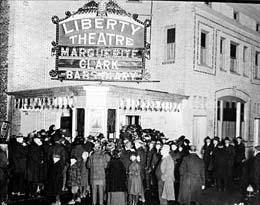On March 12, 1918, the new Liberty Theatre at 314 E Yakima Avenue in Yakima opens for business. The venue is owned and operated by Fredrick Mercy Sr. (1877-1948), a longtime Central Washington exhibitor who also operates the Majestic, Yakima, Avenue, and Empire theaters in the city. "Another splendid new theatre was added to the Frederick Mercy Theatrical Enterprises with the opening of the Liberty ... " went one report. "The Mercy enterprises have all been so well conducted that they have earned a wide popularity and the reception was the given the new house since the opening date ... has assured its success" (Motion Picture News). Interest in the theater is high, with the trade magazine Motography noting that crowds "almost fought to get in" (Motography).
Have Mercy
Frederick Mercy was born in born in Newark, New Jersey, on May 7, 1877. After completing formal schooling, he started work in the New York clothing industry, joining his father in the hat-manufacturing business. The ambitious Mercy rose quickly, eventually branching out to own a chain of eight hat stores in New York by 1908. In 1909 Mercy sold his chain and moved to San Francisco, where he turned to a new business enterprise -- motion pictures. There he opened a small movie house and vaudeville theater, operating for three years before relocating to Yakima in 1912.
In Yakima he purchased the old Majestic Theatre, at the time a small venue (250 seats), but one that Mercy would renovate over the years until it seated 800. He soon added the Empire Theatre to his list of holdings, and with similar moves in and around Yakima, began to establish himself as the area's foremost movie exhibitor.
With the Liberty, Mercy was opening one of his first brand-new theatrical venues, one of many he would open throughout his long career. Frederick Mercy died in 1948, leaving his theatrical enterprises in the capable hands of Frederick Mercy Jr., one of his three sons.
Out of the Ordinary
Frederick Mercy's new Liberty Theatre was not constructed with a formal lobby area. Instead, patrons entered directly into a windowed foyer, where they were enticed to sit and visit in a roomful of wicker furniture. This foyer -- which resembled a formal reception area -- was carpeted in emerald green and decorated throughout with wall hangings emblazoned with gold eagles. Telephone booths and several water fountains added to the patron's experience, while a bevy of female ushers (clad in blue and gray) were also on hand to assist patrons with their needs.
In the auditorium itself, gray walls were adored with Pompeian designs in gold, black, and green. Indirect lighting along the side walls aided patrons as they came and went from their seats, while large hanging lamps overhead were specially-designed to pick up the design themes and colors depicted on the walls.
At the front of the auditorium, below the screen, was a large orchestra pit that was filled to capacity with musicians on opening night. The house also owned an electric photoplayer -- a type of theater organ complete with built-in sound effects. The photoplayer was used for movie attractions that didn't warrant the employment of a full orchestra. (Eventually, in 1920, the Liberty installed a Wurlitzer organ, a hand-me-down that had already served tours of duty in two Portland theaters).
Wide Open Spaces
Although every new theater liked to note the spaciousness of its seating, this was apparently more than just a simple boast in the Liberty's case. According to Motography, the original green leather seats had to be augmented with a second order, since builders underestimated the floor space in the auditorium. (A more likely scenario: Mercy found he could cram in a few extra seats.) Regardless, the paper noted "they are so placed that the lankiest man can stretch himself at ease" (Motography).
And even on opening night, the venue was slated to grow -- Frederick Mercy was already eyeing the pending departure of a church next door to the theater, looking for the opportunity to expand its 900 seats to even more (Moving Picture News).
Entertainment with a Local Flair
Although the Liberty opened with the feature film Bab's Dairy (Famous Players, 1917), starring Marguerite Clark (1883-1940), first-night audiences got a little local flavor along with the main attraction. After an orchestral rendition of "The Star Spangled Banner," the opening film was a short specially made for the event. This showed Fredrick Mercy and his family, along with the mayor of Yakima, the fire and police chiefs, various other public officials and Mercy's own theater employees.
The Liberty Theatre continued to operate until the mid-1960s, when the venue was closed and the interior gutted. It was eventually remodeled into a bank.

